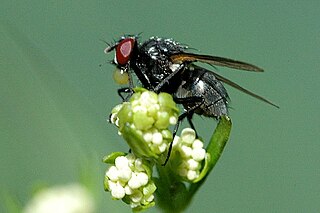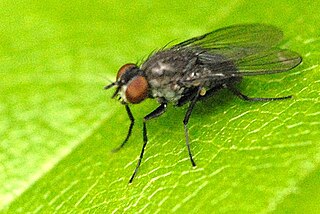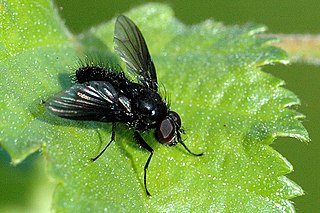| Mydaea | |
|---|---|
 | |
| Mydaea ancilla | |
| Scientific classification | |
| Kingdom: | |
| Phylum: | |
| Class: | |
| Order: | |
| Family: | |
| Subfamily: | |
| Genus: | Mydaea Robineau-Desvoidy, 1830 |
Mydaea is a large genus from the fly family Muscidae. [1] [2]
| Mydaea | |
|---|---|
 | |
| Mydaea ancilla | |
| Scientific classification | |
| Kingdom: | |
| Phylum: | |
| Class: | |
| Order: | |
| Family: | |
| Subfamily: | |
| Genus: | Mydaea Robineau-Desvoidy, 1830 |
Mydaea is a large genus from the fly family Muscidae. [1] [2]

Helina is a very large genus from the fly family Muscidae.
Pegoplata, sometimes known as Nupedia, is a genus of flies within the family Anthomyiidae.

Delia flies are members of the Anthomyiidae family within the superfamily Muscoidae. The identification of different species of Delia can be very difficult for non-specialists as the diagnostic characteristics used for immature and/or female specimens may be inconsistent between species. Past taxonomic keys were not as comprehensive in their identification of Delia specimens; they were either too reliant on genetic characteristics, focused solely on a specific life stage, or were focused only on certain species. However current taxonomic keys aim to be more thorough by not only including morphological diagnostics for males, females, and immature specimens of various species, but also their genetic make-up or molecular barcode.

Pegomya is a genus of flies within the family Anthomyiidae. Some species are considered pests due to their leafmining larvae. Species include:

Fannia is a very large genus of approximately 288 species of flies. The genus was originally described by the French entomologist Jean-Baptiste Robineau-Desvoidy in 1830. A number of species were formerly placed in the genus Musca.

Phaonia is a very large genus from the fly family Muscidae. It is distributed worldwide, with more than 750 species having been described.

Hydrotaea is a genus of insects in the housefly family, Muscidae. They occur in most regions of the world but are more populous in warmer climates. They are often found on feces in summer months, and are therefore generally found in close proximity to livestock. Among the 130 known species in this genus, one of the most commonly recognized is the dump fly.

Limnophora is a genus of flies, belonging to the family Muscidae. The flies are characterized by silver bands across their thorax. The tribe Limnophorini is named from the genus.

Coenosiini is a tribe of flies from the family Muscidae.

Thricops is a genus of true flies of the family Muscidae.

Coenosia is a very large genus of true flies of the family Muscidae.
The Cyrtoneurininae are a subfamily within the Diptera family Muscidae.

Spilogona is a very large genus of flies from the family Muscidae.

Lispocephala is a very large genus of true flies of the family Muscidae.
Caricea is a genus of house flies, in the family Muscidae. There are at least 30 described species in Caricea.

Leucophora is a genus of root-maggot flies in the family Anthomyiidae. There are at least 60 described species in Leucophora.

Chirosia is a genus of root-maggot flies in the family Anthomyiidae. There are over fifty described species in Chirosia.

Alliopsis is a genus of root-maggot flies in the family Anthomyiidae. There are at least 70 described species in Alliopsis.

Neodexiopsis is a genus of house flies, insects in the family Muscidae. There are at least 80 described species in Neodexiopsis.